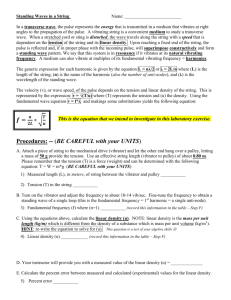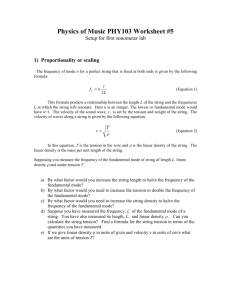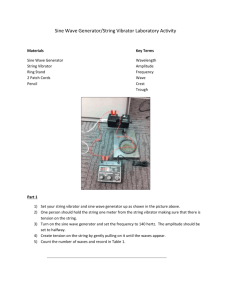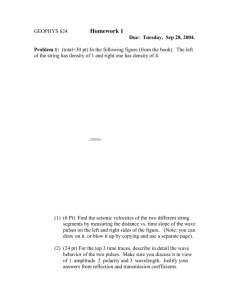Speed of waves on a string
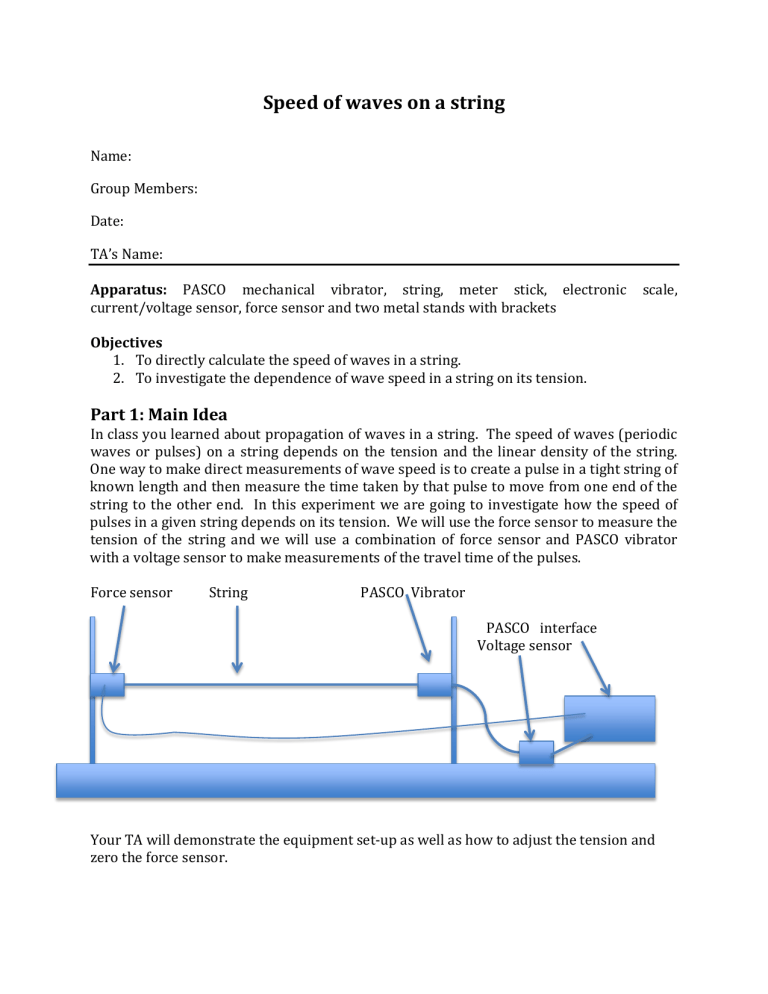
Speed of waves on a string
Name:
Group Members:
Date:
TA’s Name:
Apparatus: PASCO mechanical vibrator, string, meter stick, electronic scale, current/voltage sensor, force sensor and two metal stands with brackets
Objectives
1.
To directly calculate the speed of waves in a string.
2.
To investigate the dependence of wave speed in a string on its tension.
Part 1: Main Idea
In class you learned about propagation of waves in a string. The speed of waves (periodic waves or pulses) on a string depends on the tension and the linear density of the string.
One way to make direct measurements of wave speed is to create a pulse in a tight string of known length and then measure the time taken by that pulse to move from one end of the string to the other end. In this experiment we are going to investigate how the speed of pulses in a given string depends on its tension. We will use the force sensor to measure the tension of the string and we will use a combination of force sensor and PASCO vibrator with a voltage sensor to make measurements of the travel time of the pulses.
Force sensor String PASCO Vibrator
PASCO interface
Voltage sensor
Your TA will demonstrate the equipment set-up as well as how to adjust the tension and zero the force sensor.
Part 2: Equipment Set-up
a) Connect the force sensor and the voltage sensor to the PASCO interface. b) Connect the voltage sensor to the vibrator using red and black wire. c) Launch CAPSTONE software and select “two displays”. Then click on the middle picture and select “graph” on each one. d) Select the top graph and click on vertical axis, then select “force” from the drop down menu. e) In the lower graph select the vertical axis to be “voltage.” f) In both graphs, the horizontal axis will be time by default. g) Select the sample rate of both sensors to 1000Hz (1 kHz) from the menu located below the graphs. h) Force sensor should record pull as positive. If the force sensor displays a negative value when taking readings switch the sign.
You will create a pulse by plucking the string from the force sensor end as shown below.
The pulse will travel toward the vibrator. As the pulse reaches the vibrator, the vibrator metal strip will start to move up and down and produce a voltage. That signal is picked up by the voltage sensor and displayed on the computer. You will find the starting time of the pulse from the force graph and the arrival time of the pulse from the voltage graph as shown below. The pulse travel time is the difference between the starting time at the force sensor end of the string and the arrival time at the vibrator end of the string. This travel time and the length of the string will be used to calculate the speed of the pulse.
Part 3: Data Collection
1.
How will you calculate the speed of these pulses using your data?
2.
You will adjust the tension by moving the entire force sensor assembly away from the PASCO vibrator a little at a time, maybe half a centimeter at a time. Start with the tension at around 4.0 N and increase for each measurement, but do not exceed
15.0 N. For each measurement, first measure the tension. To do this, disconnect the string and press the zero button on the force sensor for 10 seconds. Then reattach the string. Now start recording data so that you can determine the tension.
To determine pulse speed, have one member of the group start recording the data and another member pluck the string very quickly with a pencil or pen at a point very close to the force sensor. Stop recording as soon as you can after the pluck since the travel time of the pulse is very short. Practice this a few times before you begin recording data in the table below.
Enlarge the time axis and use the coordinate reader from the graph menu to get a good reading of the start time from the force vs. time graph and the arrival time from the voltage vs. time graph. You should get times to the thousandth of a second.
If you are not satisfied with any of your readings and it does not make sense to you, then repeat the measurement and take a new data set. Take at least 4 data sets.
Tension
(N)
String length
(m)
Starting time
(s)
Arrival time
(s)
Time difference
(s)
Part 4: Data Analysis
3.
Enter your data into Excel and use it to calculate the speed of the pulses. Complete the table below. Don’t forget the units.
Tension Speed
4.
Look carefully at the table above. From your data what can you conclude about the relationship between the tension in the string and of the wave speed of the pulses?
That is, as tension of the string is increased, what happens to the speed of the pulses?
5.
You may have heard in class or read in the book that the wave speed for a string is proportional to the square root of tension (or wave speed squared is proportional to tension). You have just taken measurements of wave speeds at different tensions, so we should be able test this theory. In your Excel sheet create a column which is wave speed squared. Plot wave speed squared vs. tension. Remember to name axes, put units and name the graph. Points will be deducted for incomplete graphs.
Put a suitable trend line and equation on the graph. Copy and paste your graph to a
Word document which you will print and attach to this report at the end.
6.
Construct an argument based on the graph of your experimental results to support or refute the theory that the square of the wave speed is directly proportional to the tension of the string. Refer to specific features of your graph to defend your conclusion.
7.
Should you expect the intercept of the graph to be zero? Discuss your results.
8.
The textbook suggests that 𝑣 = �
𝑇 𝜇
or 𝑣 2 =
𝑇 𝜇
, where T is the tension and μ is the linear density. In our investigation we assumed that the linear density is constant during the experiment. Was that a reasonable assumption here? Why or why not?
9.
Calculate the linear density of the string from your graph. Compare it with measured linear density. The mass of the string can be measured using the scale.
Part 5: Conclusions
10.
What are the main sources of uncertainty in this experiment? Don’t say human error, we’ll assume you did it as well as possible given the equipment and method we used. What limitations of the equipment and method created the most uncertainty in the results?
11.
What conclusion do you make from this experiment about the relationship between wave speed and tension for waves on a string?



